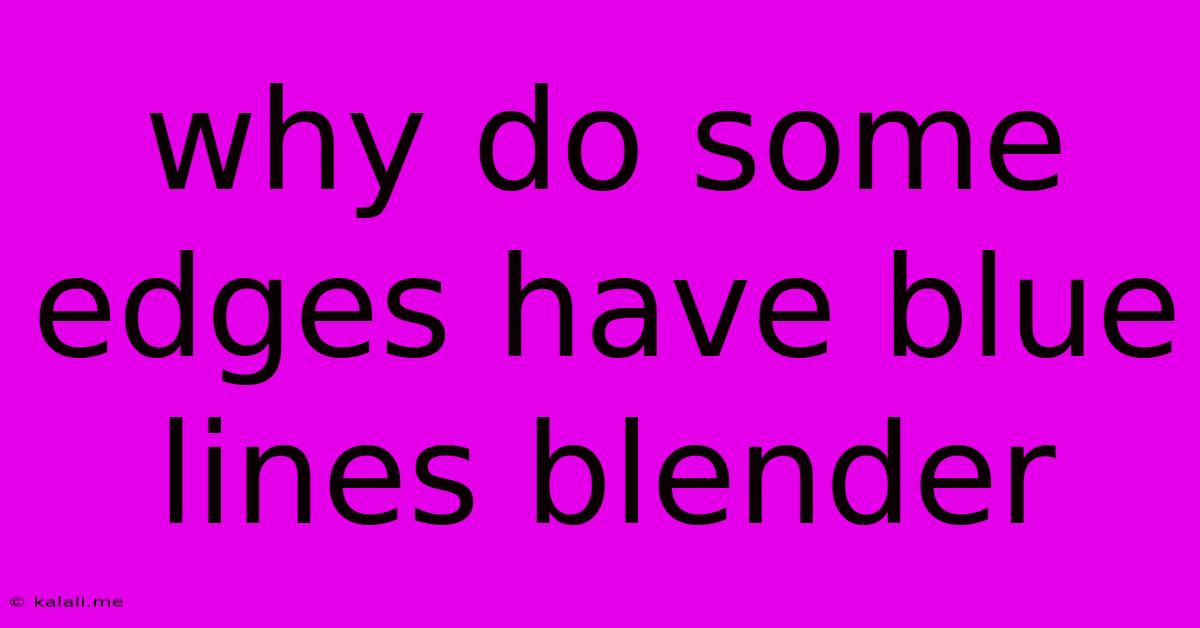Why Do Some Edges Have Blue Lines Blender
Kalali
May 25, 2025 · 3 min read

Table of Contents
Why Do Some Edges Have Blue Lines in Blender? Understanding Edge Selection and Modifiers
Blender's intuitive interface can sometimes be a bit cryptic for beginners. One common question revolves around those mysterious blue lines appearing on certain edges in your 3D models. These lines aren't a glitch; they indicate a specific selection state related to edges and often influence how modifiers operate. This article will delve into the reasons behind these blue lines, explaining their significance in different contexts. Understanding this will significantly improve your modeling workflow in Blender.
What Do the Blue Lines Mean?
The blue lines you're seeing represent selected edges that are also influenced by a modifier. This is key. A simple edge selection without a modifier active won't show blue lines; they only appear when a modifier is actively affecting those selected edges.
Think of it this way: the blue lines highlight the edges directly impacted by the modifier's calculations. They are the edges that the modifier is actively processing and manipulating. If you were to apply the modifier, these edges would be permanently altered according to the modifier's settings.
Common Modifiers that Cause Blue Lines:
Several modifiers commonly contribute to the appearance of blue lines on selected edges. Here are some prominent examples:
- Subdivision Surface: This modifier smooths out your model by adding subdivisions. The blue lines usually indicate the edges where the subdivision process is most active, often resulting in smoother curves.
- Edge Split: This modifier sharpens edges, creating a more defined look. The blue lines highlight the edges that are being "split" or sharpened by the modifier.
- Bevel: When you bevel an edge, the blue lines show which edges are being affected by the bevel operation.
- Mirror: In symmetrical modeling, if you have mirroring enabled, the blue lines on one side often indicate the edges that are being mirrored onto the other side. The lines visually represent the connection and influence of the mirroring.
How to Identify the Responsible Modifier:
If you're unsure which modifier is causing the blue lines, follow these steps:
- Check the Modifier Stack: In the Properties panel (usually on the right side of the screen), look for the "Modifiers" tab. This lists all active modifiers on your object.
- Disable Modifiers One by One: Disable each modifier temporarily to see if the blue lines disappear. The modifier that causes the lines to vanish is the culprit.
- Examine Modifier Settings: Once you've identified the modifier, carefully review its settings. The blue lines often highlight areas directly affected by the modifier's parameters.
Why Are These Lines Important?
Understanding blue lines is crucial because they directly relate to the way your model will be affected by modifiers:
- Predicting Results: They provide visual feedback, letting you anticipate the impact of modifiers before applying them.
- Precise Selection: They ensure you're working on the specific edges that will be altered by the modifier.
- Troubleshooting: If something unexpected happens after applying a modifier, examining the blue lines can help pinpoint the source of the problem.
In conclusion, the blue lines in Blender aren't an error message, but rather a valuable visual aid. Mastering their meaning will refine your understanding of modifiers and lead to more efficient and controlled 3D modeling. They are a crucial element in understanding the effect of non-destructive editing in Blender and will significantly improve your workflow.
Latest Posts
Latest Posts
-
Easier To Be Said Than Done
May 25, 2025
-
Words That Sound The Same But Have Different Meanings
May 25, 2025
-
Why Is My Ac Unit Freezing Up
May 25, 2025
-
Can You Get A Phd Without A Masters
May 25, 2025
-
How To Get Rid Of Mould In Bathroom Ceiling
May 25, 2025
Related Post
Thank you for visiting our website which covers about Why Do Some Edges Have Blue Lines Blender . We hope the information provided has been useful to you. Feel free to contact us if you have any questions or need further assistance. See you next time and don't miss to bookmark.